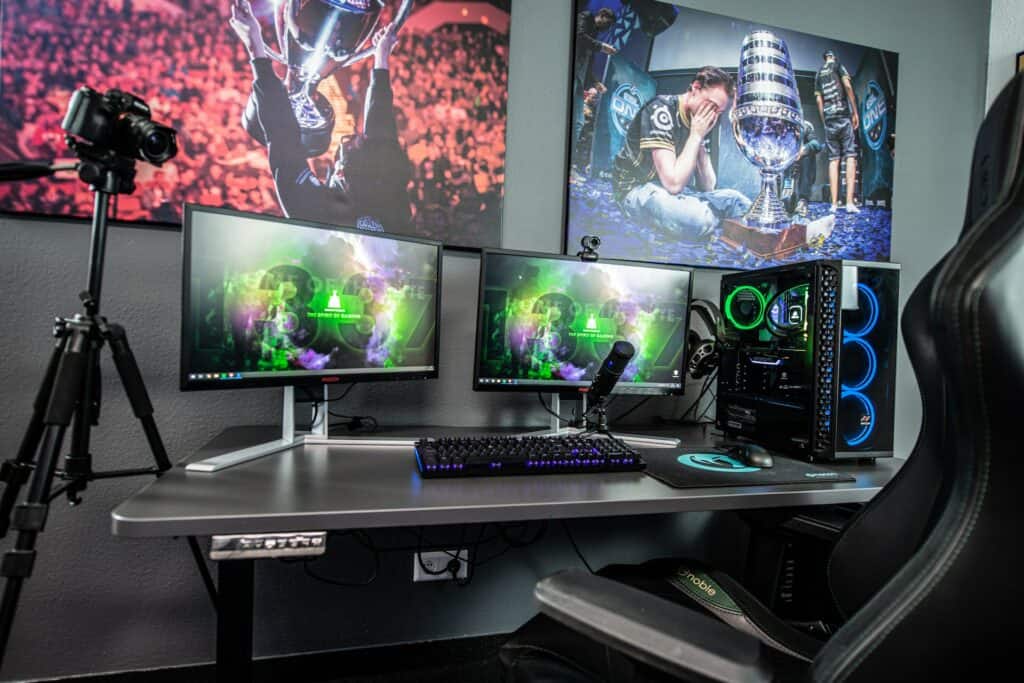For most casual tech users, 4K is the superior resolution, as it has more pixels. And while 4K is certainly the better option for many activities, the difference between the two resolutions isn’t so clear-cut in many aspects.
If you have any questions about what 1440p or 4K mean, which one is better than the other, and which one should you choose based on your needs and requirements, this 1440p vs 4K article will answer all of these questions.
1440p vs 4K – Quick Comparison
| Features | 1440p | 4K |
|---|---|---|
| Resolution | 2,560 x 1,440 | 3,820 x 2,160 4,096 x 2,160 (Cinema 4K) |
| Total Pixels | 3,600,000 | 8,294,400 |
| Standard Aspect Ratio | 16:9 | 16:9 |
| Movies/TV Shows | Great | Outstanding |
| Gaming | Great | Outstanding |
| Photo/Video Editing | Outstanding | Outstanding |
| Also Known As | QHD, WQHD, 2K | Ultra HD, UHD, UHDTV, 2,160p |
What is 1440p?
1440p, also commonly known as 2K, is a resolution that measures 2,560 x 1,440 pixels. It presents a step up from the Full HD resolution, offering considerably better and sharper images. Its QHD abbreviation means that it has Quad HD characteristics, being four times larger than 1280 x 720 HD resolution.
The 2,560 x 1,440 pixels layout is the standard QHD resolution with a 16:9 aspect ratio. Manufacturers often list ultra-wide monitors as 1440p displays, although they have more horizontal pixels and a wider aspect ratio than standard 1440p screens.
1440p displays are a bridge between 1080p and 4K screens, even though they offer picture quality that’s much closer to 4K displays. Here’s a closer look at the biggest advantages and disadvantages of 1440p:
Pros:
- More budget-friendly
- Requires a less powerful device
- Content requires less space
- Supported by more hardware
Cons:
- Still fairly expensive compared to 1080p
- Lower resolution than 4K
What is 4K?
4K or Ultra HD resolution is around 4,000 pixels wide, as you can tell from its name. More precisely, a 4K screen is any display with at least eight million active pixels. The standardized 4K resolution is 3,840 x 2,160 pixels. There’s also cinema 4K, which you can find in 4K theaters. This 4K variation has a slightly higher resolution of 4,096 x 2,160.
4K resolution is noticeably sharper than the 1080p standard display resolution, which is still the most widely used resolution. In the space that a 1080p screen holds a pixel, a 4K display of the same size can hold four pixels. Meaning, 4K displays deliver much clearer images than 1080p screens.
Of course, 4K displays also require much more bandwidth to support the more detailed image resolution. This is why the HDMI 2.0 standard was developed. With all of this in mind, 4K display technology has some clear benefits and drawbacks compared to 1440p and other display resolutions. Here are some of the most significant pros and cons of 4K:
Pros:
- More image details
- Looks better on larger screens
- More options for footage stabilization
- Better future-proofing
Cons:
- Expensive
- Current content availability

4K vs 1400 – Which is Better for Gaming?
Perhaps the biggest debate between people that favor each side is the one regarding the performance features of 1440p and 4K in terms of gaming. At first glance, you can say that 4K is better for gaming just by looking at the supported resolution.
Choosing the more suitable monitor or TV for gaming involves considering much more details than image resolution. The two most significant factors that will help you decide whether you need a 1440p or 4K screen for gaming are the hardware requirements and the overall price of the monitor setup.

4K monitors and TVs are simply much more expensive than their 1440p counterparts. Moreover, to fully enjoy the capabilities of a 4K screen, you need a powerful device with a capable graphics card. If you want smooth gaming in 4K, you’d need to budget for one of the top graphics cards in the market to play at 30 FPS to 60 FPS.
There’s also the topic of refresh rates. This aspect is crucial for gamers, as a low refresh rate causes issues like image stuttering and screen tearing. While many 1440p and 4K monitors support 60Hz and 144Hz refresh rates, you can also find a good deal of 1440p monitors with outstanding refresh rates of up to 240Hz.
Then again, if you’re not chasing the best resolution but want the smoothest gameplay possible, you’d be best off buying a 144Hz 1080p monitor. It won’t break the bank and will still provide an impressive gaming experience.
Focusing only on the choice between 1440p and 4K, we’d say that the choice is easier than it seems at first sight. 4K monitors and TVs will deliver more realistic gaming than 1440p. However, 1440p displays provide better value for money, as you can still enjoy immersive gaming with a less powerful graphics card. And, considering the prices of graphics cards in the past few years, this is arguably the smarter route to pick.
Which is Better for Editing?
Before we dig deeper into this part of our 1440p vs 4K comparison, we should say that you don’t need a 4K screen for video editing, as in some cases, it can even be a disadvantage.
On the other hand, the 1440p resolution is the minimum you should use for editing, especially if you want a monitor with a display size of 27’’ or more. With this in mind, we’ll use a 27’’ 1440p screen as the standard and look at the biggest pros and cons of 4K screens for editing in the context of that comparison.
The most apparent advantage of using a 4K monitor for editing is having more screen space to work with. That is to say, you’ll be able to create more detailed artwork, but with more zooming in and out as you work on the content.
Looking at the negative sides of using a 4K screen for photo and video editing, the most glaring downside is that you’ll likely have to scale your OS settings. In a sense, this defeats the purpose of using a 4K monitor, as you can have the same user experience with a 1440p with a less powerful device and without scaling. Plus, as is the case for gaming, running a 4K monitor for video editing requires a significantly more powerful and expensive rig.
If you want a 4K monitor for video and image editing, you should get a monitor of around 32’’ or more. That said, this is quite a massive screen size, and not everyone will have enough room on their desks for such a monitor or TV. If a 32’’ screen is too big for your setup, it’s best to stick with a 1440p screen for editing. So, overall, it’s not as much about which is better for editing but which better suits your needs and requirements.
When comparing 1440p vs 4K monitors for video and photo editing, display size and supported resolution aren’t the only factors. You should also consider the monitor’s color accuracy, brightness, aspect ratio, and other important characteristics.
When is 4K The Best Option?
Although 1440p holds its own pretty well in most comparisons, there are some areas in which 4K is simply the better option. Simply put, these are activities in which you require the most pixels to bring out all of the minute visual details of your shots. In other words, if you’re a filmmaker that wants to make highly detailed and artistic shots, 4K can help you capture everything down to the tiniest element.
4K is also a more prevalent choice for streaming platforms and many other sites that deal with video and image presentation. If you’re watching an online show and want to soak in and feel like you’re there in person, 4K can deliver the extra details that will make your experience more immersive. But again, to get the full experience without any performance issues, you’ll need a powerful enough device with a fast Internet connection.
Frequently Asked Questions
Why does 1440p look better than 4K?
The main reason why 1440p can sometimes look better than 4K is the increased refresh rate. In other words, while the images you see on the screen might be in a lower resolution, they appear smoother and more pleasant to the eyes. This is why for some users, 1440p generally looks better than 4K.
Can you tell the difference between 4K and 1440p?
There’s not a huge difference between 4K and 1440p, but if you have a keen eye, you can definitely differentiate between 4K and 1440p screens. 4K resolution appears much clearer because it has more pixels, although the jump in image quality isn’t as significant as when you’re switching from a 1080p to a 4K screen.
Can I set a 4K monitor to run 1440p?
Yes, it’s possible to set a 4K monitor to run on a lower resolution, in this case, 1440p. Viewing content and playing games in 1440p on a 4K monitor may lead to unsatisfactory results, especially if you’re used to a 4K resolution. Sometimes, the screen might appear blurry due to the lower resolution on a native 4K display.
Should I upgrade from a 1440p monitor to a 4K one?
A 4K TV or monitor is definitely considered a significant investment, so we don’t advise upgrading if you already have a 1440p display. The differences in features simply don’t justify purchasing a new screen and upgrading from 1440p.
However, if you have a 1080p TV or monitor, we advise upgrading to 1440p if you’re buying on a budget, and go for the 4K option if you have extra money to spend. In this case, the quality jump is considerable regardless if you opt for a 1440p or 4K screen.
Conclusion
As 4K screens are becoming more prevalent in the industry with each passing year, and they are also becoming more affordable for the casual consumer. The price difference between 1440p and 4K screens is still considerable, as 4K screens are still pretty niche. A 1440p or even a 1080p screen is enough for many users for work and entertainment-related purposes.
In the context of this 1440p vs 4K comparison, 4K is playing a completely different game on its own. It’s the latest hit in the gaming and photo/video editing world, and an exceedingly demanding technology, as you need a big budget to pair it with the right components. More importantly, it can be a complete overkill even for professional users.
So, ultimately, we give 1440p the overall advantage. You can run games with a less powerful (but still high-performing) device, and it’s functional enough even for professional gamers, videographers, and editors. Additionally, you have more monitors to choose from, and you can purchase a 1440p display for substantially less money than what you can get a 4K screen for.